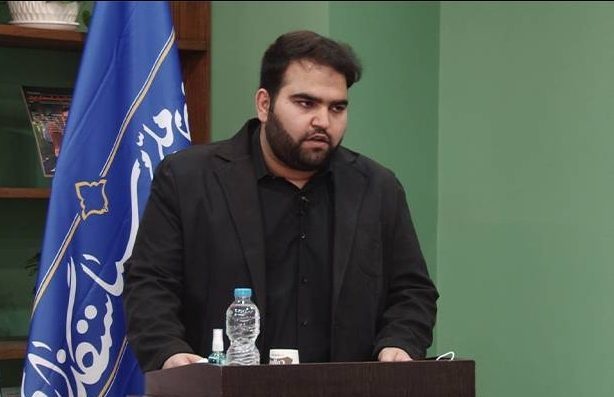According to the news agency Online News Quoted Ibna, Reza Dastjerdi He wrote: In defense of the job guarantee »Paulina Chernova, translated by Mohsen Mohammadi Ivanki and the great happiness of Shiraz Publications has been published. According to what is said, today the basis and focus of the majority of societies around the world. Work is both the basis of social order and the key to determining the status of individuals in society. But the importance of finding production has led to the concept of work in the sense of the job, and these two concepts are often considered identical and used together.
This kind of replacement is neither possible nor desirable. There are two meanings to work, one, like its activity that has its own purpose, regardless of anything else. Replacing the concept of job with the concept of work except the emphasis on the first meaning to the fullness of the second meaning of the second meaning. The claim of the job guarantee plan introduced in this book is that it can overcome the aforementioned forgetfulness and thus overcome the problem of unemployment. The link, according to the author, can double the importance of paying attention to the program and resolving the problems and problems of the environment. The following is the result of a conversation with Mohsen Mohammadi Ivanki, a translator and economic development researcher, who has also been published by “eating economics” and “developmental governments”.
****
Departure from universal basic income to universal basic job
The author in this book emphasizes that unemployment is a “political decision”. Please explain this proposition to readers more.
The idea of a job guarantee is the departure from the perspective of cash, subsidies, subsidies, and the like to job -based support. He claims that we must move from the basic income of the universal job. In fact, instead of subsidizing people, we have to give them jobs. It is based on the assumption that the author sees the subject at the political level. This is not the case that technocrats and economic officials can move forward. Both and in order to promote the implementation, the purpose of realizing the goal is to change attitudes to the political level, the will of the top political authorities, and the change of mentality.

Unemployment not only as inefficiencies but moral failure
Chernova claims that unemployment is not only ineffective but also morally ineffective. Why does the author have such a position?
He argues that unemployment is not only an economic failure but a moral failure. This claim is based on two main bases:
1. Unemployment Economic Insactivity:
-Sewing resources and intensifying the recession;
-Complete Human and Materials: Unemployment stagnates labor and production capacities. Chernova emphasizes that unemployment economics is like a motor whose half of its cylinders are off. This situation not only disrupts growth, but also exacerbates the recession by declining demand.
-Hidden costs: Passive policies (such as cash donations to unemployed) have high financial costs, while the job guarantee program produces productive employment simultaneously and reduces government spending.
-The “natural unemployment rate”: The economy considers the mainstream of unemployment to control inflation, but Chernova, citing practical experiences (such as the New American program in the 1980s), shows that full employment without inflation may be possible, if the unemployed capacities of the economy are activated.
2. Ethical issues of unemployment: violation of human dignity and social disruption
Work as a human right: Chernova, citing the Declaration of Human Rights, considers access to jobs a right than education and health. Deprivation of people from this right is a violation of human dignity.
Work beyond income: In the capitalist system, the work has been reduced to “purely monetized jobs”. Chernova argues that the work is inherent in the work:
A) the creation of identity and self -esteem;
B) the possibility of social participation;
C) maintaining communication with support networks;
Unemployment destroys these dimensions and drives one to “social elimination”.
Psychological and social impacts: Unemployment is associated with increased crime, mental illnesses, and families’ collapse. Chernova calls it a “social virus” that destroys society from within.
Career guarantee by activating unemployed resources increases total supply
How does the idea of a job guarantee fall within the theoretical framework of the “modern monetary economy”?
The basics of modern monetary theory emphasize that monetary governments (such as the United States) that publish Fiat money (non -support money) are not financially restricted in public spending because they can create new money. The main constraint is the real economy resources (labor, raw materials, technology), not financial resources. Relying on this principle, Chernova argues that the government can implement employment programs without worrying about the budget deficit, subject to unemployed production capacity in the economy (such as labor and stagnant machinery).
The foundations of modern monetary theory considers job guarantees to be an anti -cycling policy that automatically expands in recessions (with unemployment) and shrinks in boom (with the voluntary exit of workers to the private sector). This mechanism helps to stabilize prices. Unlike the conventional economy, which considers the costs of the government to be tax or debt, the theory argues that the government can afford the cost of guaranteeing job directly through money creation, without inflation, as long as the economy is not in full employment. Chernova views the cost of the program less than passive policies (such as cash donations) because employment creates tangible goods / services.
Critics of the theory warn that money creates inflation, but its supporters (including Chernova) believe that guaranteeing jobs by activating unemployed resources increases the whole supply and thus neutralizes new demand. In Argentina and India, for example, the program developed infrastructure as poverty declines. Inspired by this idea, Chernova rejects its critique of inflation and the need for the mainstream of the economy, such as the Phillips curve (the level of unemployment to control inflation) and argues that unemployment is market failure, not economic necessity. A job guarantee can lead to complete employment and low inflation at the same time.

A positive impact of artificial intelligence on job
How is it possible to guarantee a job in a world where artificial intelligence is destroying many jobs?
There is disagreement about the impact of technology on jobs. Not all thinkers and economists believe that the impact of artificial intelligence, automation, etc. on net employment is harmful, because when technology is created, it creates a series of jobs and eliminates a series of jobs. Not everyone is saying that net employment is negative. In general, many economists believe that pure job creation will probably be positive, even in artificial intelligence. And apart from it, we must have a delay in Iran to influence artificial intelligence, and my point is that it is probably not our problem today.
Types of creation and guarantee of jobs
Do you have successful examples of job guarantee in the world?
There are many examples in the book: 1. New Deal program in the United States (1980s), 2. Creating millions of public jobs in development, environmental and cultural projects under the supervision of organizations such as the Civil Protection Agency, and the Department of Labor Progress, and thus employment for 5 million people in projects such as road construction, national parks, schools and hospitals. Reduce unemployment rate from 1% to below 2% in less than 2 years, 2. Production of tangible goods and services instead of passive cash payments. Rural Employment Program in Argentina (1980s), 2. Implementation of projects such as Programma Jefes de Hogar focusing on employment in deprived areas of rural, 2. Creating 2 million jobs in agriculture, irrigation and revitalization of agricultural land, 1. Rural poverty reduction by up to 5% and increased production of agricultural products, 1. Strengthen local social networks through project participation, 1. India’s National Rural Employment Plan (NREGA) and guarantee of 4 days of work per year for each rural household in public projects such as drilling wells, road construction and forestry, 2. Creating 2 billion business days by year 2 and improving workers’ daily wages with results such as increasing women’s participation (5% of jobs were allocated to them) and the revival of local ecosystems through watershed projects.

There are also examples in Iran:
-Aqueduct in Yazd: Allocating cash aid to the aqueduct project that led to sustainable employment of farmers and a 5 % increase in aqueduct discharge;
-Poldokhtar flooded lands;
-Locals for clearing agricultural land instead of cash paying; Outcome: Revitalizing 2% of land at a cost of 2 billion USD.
Government as an entity guarantees public welfare and reduced structural inequality
What are the differences between the implementation of this policy in liberal capitalist systems (such as the US) and the Scandinavian welfare states?
These policies, such as New Dale, seek to resolve a crisis such as the Great Strength and the creation of cross -sectional employment as a cross -section, not a social right, and the government is seen only in the role of market regulator and interventionist in emergencies, not a permanent guarantee of job. But in Scandinavian welfare countries, the main purpose of ensuring sustainable employment is as a social right within the framework of a comprehensive welfare state. In the meantime, the government enters as an entity guaranteed public welfare and reduced structural inequality and seeks to link employment policy with active labor market policies (such as skill training and job adaptability) and emphasize job quality.
US funding relies on state budget deficits and borrowing (in accordance with MMT principles) for employment projects, and programs are usually temporary and dependent on the recession cycles (such as New Dale, which stopped after economic prosperity). Its employment areas include construction, environmental and minimal wage public services.
In the Scandinavian countries;
-Financial resources: Read on exponential taxes and social welfare funds, with long -term budgeting;
-Conies: Permanent and institutionalized programs in labor laws (example: right to access government jobs in Sweden);
-Employment Areas: Focusing on social services, elderly care, training and green technology with competitive wages and complete insurance coverage;
India and Argentina successful examples
Do you think this policy is also used in developing countries?
Job Guarantee, which Paulina Chernova explains in the book, is used not only in developed countries, but also in developing countries, but its implementation has certain challenges and requirements. Successful examples of developing are this;
-Hand: NREGA (Rural Employment) Program: Guarantee 2 days a year for every rural household in public projects such as irrigation, forestry and road construction; Creating 2 billion business days by year 2; Increasing 2 % of villagers’ wages and participation of 2 % of women; Restoring local ecosystems through watershed projects.
-Argentina: Jefes de Hogar app
Creating jobs in agricultural and infrastructure sectors for poor household heads, including a 5 % reduction in rural poverty and increased agricultural production; And strengthen local social networks.
The need to redefine the role of the government and revise the monetary -financial policy
Does the implementation of this project require a change in the structure of economic governance?
Chernova points out in his book that the project is not only possible with superficial reforms, but also requires redefining the role of the government, revising monetary-financial policies, and changing economic institutions, such as. Crossing passive policies (merely UBI payment), 1. Establishment of a specialized supervisory body like India, 1. Restopion of the monetary system for countries that do not have monetary governing or have dollars dependent, tax use, and so on. Improvement of the education system, 1. Restore the relationship between the worker and the employer and the improvement of the workers’ bargaining power.
1
منبع: www.khabaronline.ir








